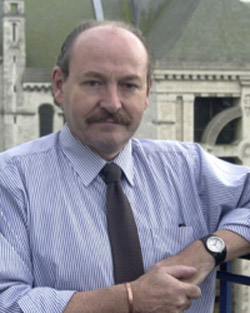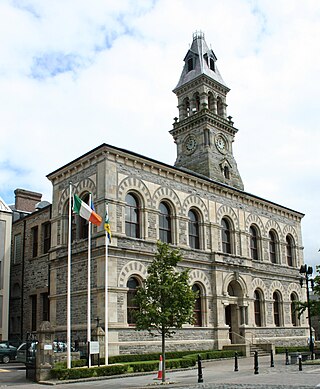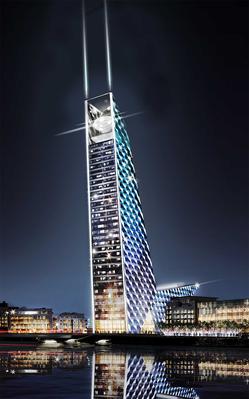| | |
| Formation | 1973 |
|---|---|
| Dissolved | 2012 |
| Purpose | Community arts centre in inner city Dublin, gallery, residencies, studios, music programmes |
City Arts Centre (CityArts) was a community arts organisation in central Dublin founded in 1973 and liquidated in 2012.
| | |
| Formation | 1973 |
|---|---|
| Dissolved | 2012 |
| Purpose | Community arts centre in inner city Dublin, gallery, residencies, studios, music programmes |
City Arts Centre (CityArts) was a community arts organisation in central Dublin founded in 1973 and liquidated in 2012.
Originally called the Grapevine Arts Centre, what became the City Arts Centre occupied a number of premises in the centre of Dublin, beginning at Mary Street and then North Great Georges Street, North Frederick Street, and Moss Street, before purchasing a location at Bachelor's Walk in 2010. The organisation grew from a need by a group of teenagers in what has been called Dublin's culturally bleak mid-20th century, with particular issues for those from a working-class background, which was the case for most of the Grapevine founders. This is also the reason why the location of the centre was the unfashionable Northside inner city. The three main initiators of the project were Jackie Aherne, Anto Fahy and Sandy Fitzgerald.
As the 1970s progressed, the organisation became more culturally politicised, linking in with the radical community arts movement in the UK. This collaboration resulted in a wider world view and a move to work for a different perspective on culture, one that recognised difference and the rights of people with regard to cultural equality. Linking with similar projects that had emerged (notably City Workshop and Moving Theatre in Dublin and Neighbourhood Open Workshops in Belfast) in Ireland by the early 1980s, the community arts movement grew to be a force for change, resulting in new policies and perspectives that sought to challenge cultural orthodoxy. In 1984, the representative group CAFE (Creative Activity For Everyone) was formed, with Grapevine as a founding member.

Grapevine's artistic programme grew alongside its philosophical awareness and was diverse and multifaceted, taking place within the centre, around the suburbs of Dublin and throughout Ireland. Examples of this diversity include its street theatre programme, directed by Thom McGinty (later to become the Diceman), hair cutting, street fashion design studio, audio art, street events, gigs and random acts of fun in public places. They had an innovative visual arts programme directed for a while[ when? ] by artist John Carson, later of Artangel in the UK. This included early shows by John Kindness amongst others including an exhibition of drawings from the survivors of Hiroshima, organised in association with a young U2.
The relationship with U2 continued into the centre's next phase when, in 1988, there was a name change from Grapevine Arts Centre to City Arts Centre when the organisation occupied a warehouse building on Moss Street near Tara Street Station, then the largest centre of its kind in Ireland. U2 provided fully equipped rehearsal spaces for young bands in the basement. Over this was a cafe and theatre space initially run by Declan Gorman and above that a gallery space initially run by Tommy Weir. Sandy Fitzgerald continued as Director through to 2001. The Arts Council never fully backed the centre, favouring the Project Arts Centre.[ citation needed ]
The Centre actually owned the Moss Street building, having bought it in a then run-down area. However, the property become rather valuable. There was an opportunity to create a large civic project, when a partnership between City Quay School to the rear of the centre and a community hall adjacent to the centre were brought into a scheme for an innovative socio/cultural project at the entrance to the docklands, then at the beginning of its transformation. The scheme needed a piece of vacant land that linked all the properties but Dublin Dockland Development Authority rejected the idea, although both Dublin City Council and The Arts Council, plus all the local elected representatives, supported the project. As a result, City Arts Centre became an anomaly within the dockland development. Sandy Fitzgerald stepped down as director of the centre in 2000, after 27 years. City Arts did not receive Arts Council funding in 2001. [1] [2]

Declan McGonagle was hired as director, and under his leadership the centre began a process of cessation, starting with its closure for 2 years, with all staff made redundant and all activities stopped. City Councilor Mannix Flynn, on the closure of the City Arts Centre, said that “Dublin lost an arts community down there, the community lost an arts centre, lost employment”. [3] McGonagle launched a 'Civil Arts Inquiry' (a two-year series of "conferences and recorded public debates") meanwhile earning €50,000 per year. [2] [4] [5] The 'Inquiry' had skeptics, dismissing it for not engaging with the art community and as a profit-driven waste of time, without producing any results. [6] [2]
The centre's building and property on Moss St in central Dublin was sold in 2003 for more than €4.2 million, making it the richest arts organisation in Ireland at the time. [2] After the sale, the City Arts Centre spent the next few years in a basement office and in 2007 bought a smaller building on Bachelor's Walk. However, it needed repairs and only reopened in 2010 (as CityArts). At this time the organisation had spent nearly all of its savings between operational costs, archiving, the 'Civil Arts Inquiry', redundancy packages, and the new building with renovations. [2] In 2012 CityArts voluntarily liquidated, with the new building becoming the property of Dublin City Council. As of 2021, the Moss Street building remained unused and undeveloped, [3] [7] but after 18 years of inactivity it went up for sale in April 2021 for €35 million. [8] In 2022, Dublin City Council refused planning permission for a 24-storey office building on the site, this decision was upheld by An Bord Pleanála on appeal and as of 2024 the site remains derelict. [9]
In 2004 the book 'An Outburst of Frankness: Community Arts In Ireland - A Reader' was published by Tasc at New Island. This book, edited by Sandy Fitzgerald, goes into some detail about the history of community arts in Ireland, backed up by essays on the theory and practice of this movement.[ citation needed ]
Throughout the 25-year life of City Arts, there were a number of varied and quite popular events, some of which gained press, popular and political attention. [10]

Declan McGonagle is a well-known figure in Irish contemporary art, holding positions as director at the Orchard Gallery in Derry, the first director at the Irish Museum of Modern Art, and as director of the National College of Art and Design, Dublin. He writes, lectures and publishes regularly on art and museum/gallery policy issues, and curates exhibitions.

Cardiff Bay is an area and freshwater lake in Cardiff, Wales. The site of a former tidal bay and estuary, it is the river mouth of the River Taff and Ely. The body of water was converted into a 500-acre (2.0 km2) lake as part of a UK Government redevelopment project, involving the damming of the rivers by the Cardiff Bay Barrage in 1999. The barrage impounds the rivers from the Severn Estuary, providing flood defence and the creation of a permanent non-tidal high water lake with limited access to the sea, serving as a core feature of the redevelopment of the area in the 1990s.

Sligo is a coastal seaport and the county town of County Sligo, Ireland, within the western province of Connacht. With a population of 20,608 in 2022, it is the county's largest urban centre and the 24th largest in the Republic of Ireland.

Ringsend is a southside inner suburb of Dublin, Ireland. It is located on the south bank of the River Liffey and east of the River Dodder, about two kilometres east of the city centre. It is the southern terminus of the East Link Toll Bridge. Areas included in Ringsend are the south side of the Dublin Docklands, and at the west end is the area of South Lotts and part of the Grand Canal Dock area. Neighbouring areas include Irishtown, Sandymount and the Beggars Bush part of Ballsbridge to the south, and the city centre to the west. A key feature of the area is the chimneys of Poolbeg power station.

Spencer Dock is a former wharf area, close to where the Royal Canal meets the River Liffey, in the North Wall area of Dublin, Ireland. As of the 21st century, the area has been redeveloped with occupants of the Spencer Dock development including the Convention Centre Dublin, PricewaterhouseCoopers' Irish headquarters, Credit Suisse and TMF Group. The Central Bank of Ireland and NTMA have offices in the nearby Dublin Landings development.

East Wall is an inner city area of the Northside of Dublin, Ireland. Built on reclaimed ground in the 1820s, the area is also 30 minutes walk from Dublin's main thoroughfare, O'Connell Street.
The Dublin Docklands Development Authority (Irish: Údarás Forbartha Dugthailte Bhaile Átha Cliath) (DDDA) was created by the Dublin Docklands Development Authority Act 1997 to lead a major project of physical, social and economic regeneration in the East side of Dublin, Ireland, along both banks of the River Liffey. On 31 May 2012 the Irish government announced its intention to wind up the Authority. The full dissolution was due to take place in May 2014 with a plan to phase the organisation into the Docklands Consultative Forum. At the time, this plan was postponed due to disengagement of the DDDA leading up to the dissolution date. The Authority was officially dissolved on 1 March 2016.

North Wall is an area east of the inner north side of Dublin, along the River Liffey where it forms one of the Dublin quays.

Dublin Docklands is an area of the city of Dublin, Ireland, on both sides of the River Liffey, roughly from Talbot Memorial Bridge eastwards to the 3Arena. It mainly falls within the city's D01 and D02 postal districts but includes some of the urban fringes of the D04 district on its southernmost side.

The U2 Tower was a cancelled skyscraper which was proposed to be constructed in Dublin, Ireland. The site proposed was in the South Docklands (SODO) campshires, at the corner of Sir John Rogerson's Quay and Britain Quay, by the confluence of the River Liffey, the River Dodder, and the Grand Canal. The design announced on 12 October 2007 was by Foster and Partners. Reports suggested a building height of 120 metres, "well over 120 metres", and 180 metres, any of which would have made it the tallest building on the island of Ireland. The building was planned to be an apartment building, with a recording studio owned by the rock group U2 in a "pod" at the top. Construction was to begin in 2008 and end in 2011, at a cost of €200m. In October 2008, the project was cancelled because of the economic downturn at the time. Proposals to revive the plan were reported in July 2013. However, they did not come to fruition and the 79-metre, 22-storey Capital Dock development has since been built on the site.
Grand Canal Dock is a Southside area near the city centre of Dublin, Ireland. It is located on the border of eastern Dublin 2 and the westernmost part of Ringsend in Dublin 4, surrounding the Grand Canal Docks, an enclosed harbour where the Grand Canal comes to the River Liffey. The area has undergone significant redevelopment since 2000, as part of the Dublin Docklands area redevelopment project.

Sir John Rogerson's Quay is a street and quay in Dublin on the south bank of the River Liffey between City Quay in the west and Britain Quay. Named for politician and property developer Sir John Rogerson (1648–1724), the quay was formerly part of Dublin Port. It has some of the few remaining campshire warehouses in Dublin.

Britain Quay is a street and quay in Dublin on the south bank of the River Liffey between Sir John Rogerson's Quay and the confluence of the River Liffey, River Dodder and Grand Canal.

Boland's Mill is located on the Grand Canal Dock in Dublin, Ireland on Ringsend Road between the inner basin of Grand Canal Dock and Barrow Street. As of 2019, it was undergoing a €150 million reconstruction to become Bolands Quay, a development of new residences and commercial, retail, and civic spaces. The site, originally associated with Boland's Bakery, includes a number of 19th century warehouses.

George's Dock is a Georgian dock in the Docklands area of Dublin forming part of the International Financial Services Centre.
TradFest is an annual music and culture festival that takes place at the end of January in Dublin, Ireland. Founded by the Temple Bar Company, a not-for-profit organisation who work on behalf of businesses in the cultural quarter of Temple Bar, Dublin, as well as programming events on Moore Street and in Fingal, this festival celebrates Irish traditional and folk music and cultural offerings. It was launched on January 26, 2006.
Silicon Docks is a nickname for the area in Dublin, Ireland around Grand Canal Dock, stretching to the IFSC, city centre east, and city centre south near the Grand Canal. The nickname makes reference to Silicon Valley, and was adopted because of the concentration of European headquarters of high-tech companies such as Google, Facebook, Twitter, LinkedIn, Indeed and startups in the area. The number of tech professionals working in technology firms in the area is about 7,000.
The Docklands Strategic Development Zone (SDZ) (known officially as the North Lotts and Grand Canal Dock SDZ Planning Scheme) is a controversial strategic planning area in Dublin, Ireland located east of the city centre on both sides of the River Liffey in the North Wall and Grand Canal Dock areas.

Capital Dock is a 22-storey mixed-use development at the junction of Sir John Rogerson's Quay and Britain Quay in the Dublin docklands. Developed by Kennedy Wilson, the site was acquired in 2012 and construction finished in 2018. Upon completion, the 79-metre tower became the tallest storeyed building in the Republic of Ireland, and the third tallest on the island of Ireland.